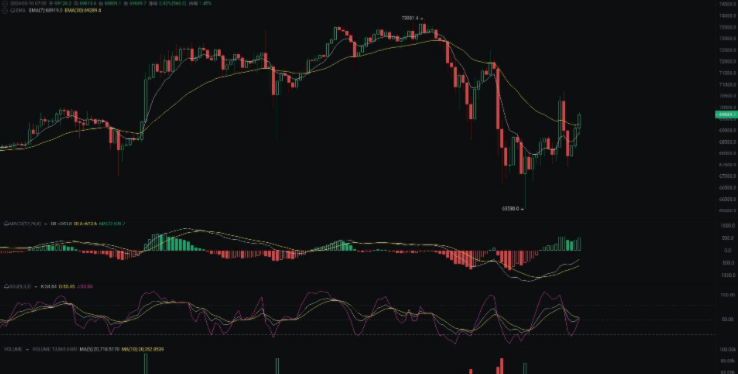Learn in one article: The difference between mainstream coins and altcoins
Understand the difference between mainstream coins and altcoins: Mainstream coins, such as Bitcoin and Ethereum, are known for their high market capitalization, circulation, and wide recognition. Altcoins, such as Dogecoin and Ripple, have lower market caps, are more volatile, and are often tied to specific use cases. Understanding these differences is critical for investors as it affects their investment strategies and risk assessments.

Learn in one article: The difference between mainstream coins and altcoins
Introduction
In the vast world of cryptocurrency, mainstream Coins and altcoins constitute two major camps. Understanding the differences between them is crucial for investors as it will impact their investment strategies and risk assessments. This article deeply explores the definition, characteristics, advantages and disadvantages of mainstream coins and altcoins, aiming to help readers thoroughly understand their nature and investment value.
Definition of mainstream coins and altcoins
Mainstream coins
- Cryptocurrencies with the top market capitalization usually have high circulation and activity.
- has been widely recognized and adopted, and has a strong market position and liquidity.
- For example: Bitcoin (BTC), Ethereum (ETH), Binance Coin (BNB).
Altcoins
- Cryptocurrencies with lower market capitalization, usually with lower circulation and activity.
- Compared with mainstream currencies, it has greater volatility and risk.
- is often related to specific use cases or applications, such as DeFi, privacy coins, public chains, etc.
Main Differences
- Market Cap and Circulation: Mainstream coins usually have higher market cap and circulation, while altcoins are relatively smaller .
- Volatility: Altcoins tend to be more unstable and have greater price fluctuations than mainstream coins.
- Acceptance: Mainstream coins are more widely accepted, while altcoins may have lower acceptance or be limited to specific communities.
- Risk: Altcoins generally carry higher risk as they are more immature, less liquid, and can be subject to pull and sell.
- Use cases: Mainstream coins are mainly used as a store of value and medium of exchange, while altcoins have a wider range of use cases, such as smart contract execution, DeFi, privacy, etc.
Advantages
Advantages of mainstream currencies
- Security: The market capitalization is large and mature, with strong network security.
- Liquidity: High liquidity, easy to buy and sell, and easy to cash out.
- Recognition: Widely recognized and accepted, with high credibility.
- Store of Value: Relative stability and predictability as a store of value.
Advantages of altcoins
- Innovation: Focus on specific use cases or applications to promote the cryptocurrency ecosystem Systematic innovation.
- Potential Return: Higher volatility comes with potentially high returns, but also comes with higher risk.
- Diversification: Provides diversification to an investment portfolio, reducing risk and increasing potential returns.
- Support small projects: Investing in altcoins can support the development of emerging cryptocurrency projects and ecosystems.
Disadvantages
Disadvantages of mainstream currencies
- Price fluctuations: Although more stable than altcoins, there is still the risk of price fluctuations .
- Transaction Fees: Due to high traffic, transaction fees for mainstream coins may be higher.
- Competition: Mainly focused on a few cryptocurrencies, resulting in fierce competition.
- Lack of innovation: Mainstream coins may have a slower pace of innovation as they focus on maintaining stability and security.
Disadvantages of altcoins
- High risk: High volatility, low liquidity, high risk of pull and sell.
- Scam: There are many scams in the altcoin market and you need to invest with caution.
- Lack of acceptance: Limited acceptance and limited usage scenarios.
- Immature: The technology is immature and network security may have vulnerabilities
Frequently Asked Questions (FAQ)
1. What is market capitalization?
Market capitalization refers to the market value of all tokens in circulation of a cryptocurrency, usually calculated in U.S. dollars or other fiat currencies.
2. What is liquidity?
Liquidity refers to the ease with which an asset can be bought and sold. Cryptocurrencies with high liquidity can be easily bought and sold, while cryptocurrencies with low liquidity can be difficult to buy and sell and costly to trade.
3. What are pull and sell?
Pumping is the rapid purchase of large amounts of a cryptocurrency, pushing up its price. Sell-off refers to the rapid and large selling of a cryptocurrency, causing the price to fall.
4. What is DeFi?
DeFi (decentralized finance) refers to financial applications built on blockchain platforms. It allows users to borrow, trade, manage money and perform other financial activities without the need for intermediaries.
The above is the detailed content of Learn in one article: The difference between mainstream coins and altcoins. For more information, please follow other related articles on the PHP Chinese website!

Hot AI Tools

Undresser.AI Undress
AI-powered app for creating realistic nude photos

AI Clothes Remover
Online AI tool for removing clothes from photos.

Undress AI Tool
Undress images for free

Clothoff.io
AI clothes remover

Video Face Swap
Swap faces in any video effortlessly with our completely free AI face swap tool!

Hot Article

Hot Tools

Notepad++7.3.1
Easy-to-use and free code editor

SublimeText3 Chinese version
Chinese version, very easy to use

Zend Studio 13.0.1
Powerful PHP integrated development environment

Dreamweaver CS6
Visual web development tools

SublimeText3 Mac version
God-level code editing software (SublimeText3)

Hot Topics
 How much is Bitcoin worth
Apr 28, 2025 pm 07:42 PM
How much is Bitcoin worth
Apr 28, 2025 pm 07:42 PM
Bitcoin’s price ranges from $20,000 to $30,000. 1. Bitcoin’s price has fluctuated dramatically since 2009, reaching nearly $20,000 in 2017 and nearly $60,000 in 2021. 2. Prices are affected by factors such as market demand, supply, and macroeconomic environment. 3. Get real-time prices through exchanges, mobile apps and websites. 4. Bitcoin price is highly volatile, driven by market sentiment and external factors. 5. It has a certain relationship with traditional financial markets and is affected by global stock markets, the strength of the US dollar, etc. 6. The long-term trend is bullish, but risks need to be assessed with caution.
 Bitcoin price today
Apr 28, 2025 pm 07:39 PM
Bitcoin price today
Apr 28, 2025 pm 07:39 PM
Bitcoin’s price fluctuations today are affected by many factors such as macroeconomics, policies, and market sentiment. Investors need to pay attention to technical and fundamental analysis to make informed decisions.
 What currency does Ripple (XRP currency) belong to? Detailed tutorial for beginners
Apr 28, 2025 pm 07:57 PM
What currency does Ripple (XRP currency) belong to? Detailed tutorial for beginners
Apr 28, 2025 pm 07:57 PM
Created by Ripple, Ripple is used for cross-border payments, which are fast and low-cost and suitable for small transaction payments. After registering a wallet and exchange, purchase and storage can be made.
 Which of the top ten currency trading platforms in the world are among the top ten currency trading platforms in 2025
Apr 28, 2025 pm 08:12 PM
Which of the top ten currency trading platforms in the world are among the top ten currency trading platforms in 2025
Apr 28, 2025 pm 08:12 PM
The top ten cryptocurrency exchanges in the world in 2025 include Binance, OKX, Gate.io, Coinbase, Kraken, Huobi, Bitfinex, KuCoin, Bittrex and Poloniex, all of which are known for their high trading volume and security.
 Top 10 virtual currency trading apps Latest rankings of top 10 virtual currency trading platforms in 2025
Apr 28, 2025 pm 02:09 PM
Top 10 virtual currency trading apps Latest rankings of top 10 virtual currency trading platforms in 2025
Apr 28, 2025 pm 02:09 PM
The top ten virtual currency trading apps are: 1. OKX, 2. Binance, 3. gate.io, 4. Coinbase, 5. Kraken, 6. Huobi, 7. KuCoin, 8. Bitfinex, 9. Bitstamp, 10. Poloniex. Each platform has outstanding performance in trading products, user experience, security, etc., to meet the needs of different investors.
 Spot King Transformation Note: How to layout the next generation of on-chain ecosystem with Gate.io MeMebox 2.0?
Apr 28, 2025 pm 03:36 PM
Spot King Transformation Note: How to layout the next generation of on-chain ecosystem with Gate.io MeMebox 2.0?
Apr 28, 2025 pm 03:36 PM
Gate.io has achieved the transformation from spot trading to on-chain ecosystem through MeMebox 2.0. 1) Build a cross-chain infrastructure and support the interoperability of 12 main chains; 2) Create a DeFi application ecosystem and provide one-stop services; 3) Implement incentive mechanisms and reconstruct value allocation.
 Top 10 commonly used cryptocurrency trading software rankings in 2025
Apr 28, 2025 pm 05:45 PM
Top 10 commonly used cryptocurrency trading software rankings in 2025
Apr 28, 2025 pm 05:45 PM
The top ten cryptocurrency trading software rankings in 2025 include Binance, OKX, gate.io, etc., all of which provide a variety of trading models and rigorous security measures.
 Sesame Open Door Official Website Entrance Sesame Open Door Official Latest Entrance 2025
Apr 28, 2025 pm 07:51 PM
Sesame Open Door Official Website Entrance Sesame Open Door Official Latest Entrance 2025
Apr 28, 2025 pm 07:51 PM
Sesame Open Door is a platform that focuses on cryptocurrency trading. Users can obtain portals through official websites or social media to ensure that the authenticity of SSL certificates and website content is verified during access.






